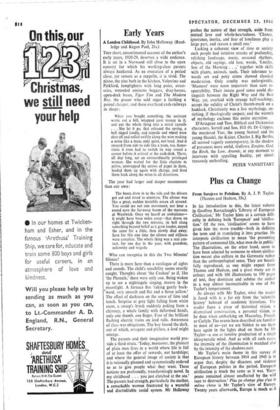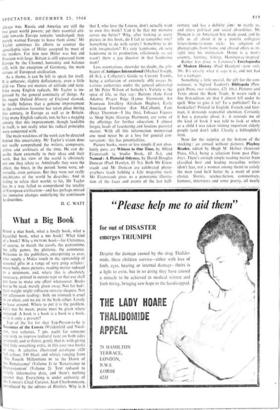Plus ca Change
From Sarajevo to Potsdam. By A. J. P. Taylor. (Thames and Hudson, 35s.)
IN his introduction to this, the latest volume in Geoffrey Barraclough's 'Library of European Civilisation,' Mr Taylor hints at a certain diffi- culty in defining both 'European' and 'civilisa- tion.' Of the two, 'civilisation' seems to have given him the more trouble—both in defining the term and in translating it into practice. He interprets civilisation to mean 'the preventing pattern of communal life, what men do in public.' The illustrations, on the other hand, seem to have been selected by someone to whom civilisa- tion meant also culture in the Germanic rather than the anthropological sense. They are beauti- fully reproduced, as one might expect from Thames and Hudson, and a great many are in colour; and with 166 illustrations to 190 pages of text, they dominate and subdue the author in a way almost inconceivable in one of Mr Taylor's temperament.
As always with Mr Taylor, what the reader is faced with is a far cry from the 'scientific history' beloved of academic historians. The reader faces a piece of historical vision, a dramatised construction, a personal vision, as he does when embarking on Macaulay, Fronde or Carlyle. The events here described are familiar to most of us—yet we are bidden to see them here again in the lights shed on them by Mr Taylor—a son et lumiere production of a single idiosyncratic mind. And as with all such cases, the intensity of the illumination is matched alto by the intensity of the shadows cast. Mr Taylor's main theme in this survey of European history between 1914 and 1945 is to argue that, despite the disasters and violence of European politics in the period, European civilisation is much the same as it was. 'Euro- peans remained almost unaffected by the wild race to destruction.' Plus ga change plus c'est la meme chose is Mr Taylor's view of Europe. Twenty years afterwards, Europe is much as it always was. Russia and America are still the two great world powers; yet their essential atti- tude towards Europe remains 'unchanged; they merely wanted Europe to leave them alone.' Mr Taylor continues his efforts to counter the apocalyptic view of Hitler accepted by most of his readers. For him new Hitler was but old Prussian writ large. Britain is still separated from Europe by the Channel, humanity and balance still, with the exception of Germany, the main virtues of European civilisation.
As a theme, it can be left to speak for itself. It is unheroic, slightly deflationary, even a little drjd vu. These are matters of attitude and taste. Like many English radicals, Mr Taylor is im- pressed by the general continuity of things. As his recent Oxford History of England showed, he really believes that a genuine improvement in the condition hunzaine has taken place during this century, in Europe as well as in Britain. I ike many English radicals, too, he has a nagging anxiety that this improvement, though laudable in itself, is not really what his radical principles were concerned with.
The main weakness of the work can be detected behind this uncertainty. Mr Taylor's vision does not really comprehend the writers, composers, artists and architects of the time. He can de- scribe them externally in their ideas and their work. But his view of the world is obviously not one they relate to. Admittedly they were the ablest, the finest, in the period. Some were, ad- mittedly, even geniuses. But they were not really inhabitants of the world he describes. And in failing to relate their worlds to his, Mr Taylor has in a way failed to comprehend the totality of European civilisation—and has perhaps missed the immense changes underlying the continuum he describes.
D. C. WATT































 Previous page
Previous page